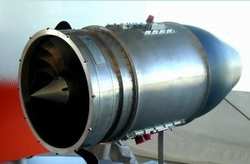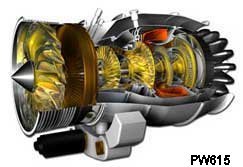ANN's Exclusive Interview With Eclipse CEO Vern Raburn
 "Last year at Oshkosh," Eclipse CEO Vern
Raburn began, "we fully intended to fly on the first day of the
convention. We were bringing in a Jumbotron, and we were going to
'broadcast' the first flight, at the show."
"Last year at Oshkosh," Eclipse CEO Vern
Raburn began, "we fully intended to fly on the first day of the
convention. We were bringing in a Jumbotron, and we were going to
'broadcast' the first flight, at the show."
"We're nothing if not aggressive," he noted; but, as the little
things that always crop up, cropped up, he didn't get that
broadcast going. "...but we're not stupid." What happened? "We were
ready... Williams was anything but." Eclipse had held its rollout
celebration just days earlier, and it was, um, 'close.' They had
planned to bring the airplane out under its own power, but "just
one was working." The roll-out was made without the engine
noise.
 On August 26, 2002, the
Eclipse 500 made its first flight (right). "The NBAA convention
[held immediately thereafter] was wonderful." There were problems,
though. Eclipse was not impressed by the performance of the
Williams EJ22.
On August 26, 2002, the
Eclipse 500 made its first flight (right). "The NBAA convention
[held immediately thereafter] was wonderful." There were problems,
though. Eclipse was not impressed by the performance of the
Williams EJ22.
"Three days after that flight, Williams came in to the factory
with a 5-hour presentation: 'Here's how we're going to solve all
the problems,' they said." Raburn told us that was the first time
they had acknowledged that the problems even existed.
Time's A-wasting.
"We were supposed to have certified engines in May of this year,
for us to get the airplane certified by December," Raburn said. "In
October 2002, they announced -- they didn't confer with us -- that
they would slip certification to November." Why didn't Raburn cut
and run at that time? "We were still committed -- we had spent
millions. We were profoundly troubled, and we were concerned about
those engines. We said so at NBAA."
 Things hadn't gone well
in Walled Lake (MI), Williams' HQ. "By October 1, Williams had
tested about half their 'fixes' -- and not one of them
worked," Raburn said. "They tested in non-real-world
conditions. For instance, they would blow-start the engines. The
starters we got would fail after about every 25 starts. We finally
rigged up a bucket of ice to run tubing through, to blow
refrigerated air through the starters." Williams, too, had been
aggressive in their delivery program, trying two novel starters,
neither of which, Mr. Raburn said, worked very well.
Things hadn't gone well
in Walled Lake (MI), Williams' HQ. "By October 1, Williams had
tested about half their 'fixes' -- and not one of them
worked," Raburn said. "They tested in non-real-world
conditions. For instance, they would blow-start the engines. The
starters we got would fail after about every 25 starts. We finally
rigged up a bucket of ice to run tubing through, to blow
refrigerated air through the starters." Williams, too, had been
aggressive in their delivery program, trying two novel starters,
neither of which, Mr. Raburn said, worked very well.
Eclipse developed a self-start module which didn't work too
well, either, Raburn noted.
Eventually, he said, "They went to a conventional starter that
was built for 400 amps, and pumped 600 amps through it."
 So, Vern said, "by
mid-October of last year, we realized that the engine was just too
delicate. We weren't ready to accept their two standard
positions:
So, Vern said, "by
mid-October of last year, we realized that the engine was just too
delicate. We weren't ready to accept their two standard
positions:
- yes, there is a problem; send money; or
- we have it fixed, but there's no guarantee."
Indignation was the next phase.
The clock was running, and Raburn said patience was wearing
thin. "They [Williams] were offended that we questioned anything
they were doing -- everything, to them, was an airframe problem...
Eclipse management finally convinced the Board that the problems
were not going to get solved. The Board was sympathetic, but wanted
to be sure. They hired a world-class consultant -- everybody uses
him, and everybody agrees he's tops -- and told Williams he would
look into things. The Board demanded that the consultant have
access to everything at Williams that pertained to our program --
they hadn't let us see much of anything until then." Raburn
continued, noting the good news and the bad.
The good news was that, "Our expert was given
everything;" and the bad news was that he wrote, "a scathing
report, that said Williams was 2, maybe 3 years from certification.
Williams had never done such things. Some of the things they were
trying to do had never been done, by anyone, on any size
engine."
Raburn took a deep breath. "Finally, I got permission from the
Board, and kicked them out. There was a lot of gnashing of teeth...
We had a legal argument; they had a contract. We could get into the
business of suing people, sort of 'Eclipse LLC,' and let the
Eclipse [airplane] meanwhile just kind of go away; or we could
terminate the agreement."
 Facing the great
unknown of just what suitable engine would become available,
Eclipse set about testing two sides of the market: it asked its
customers which jet engine producer they would prefer, and they
asked manufacturers what engines would be available, and in what
timeframe.
Facing the great
unknown of just what suitable engine would become available,
Eclipse set about testing two sides of the market: it asked its
customers which jet engine producer they would prefer, and they
asked manufacturers what engines would be available, and in what
timeframe.
"This was a very difficult time, Raburn remembered, "even though
we had our vision, these are BIG companies -- and they had to act
in a way in which they weren't accustomed to acting. Each company
had its 'Eclipse supporters' inside, and each group of supporters
needed to work hard to convince its Board."
Tension built, as the time ticked away...
"We were fighting for our lives," Raburn recalled, "and they
were making $100 million decisions in what was an unquestionably an
unfriendly economy, and an unfriendly environment, overall."
"It's remarkable," Vern said, "that a Fortune 25 company, within
75 days, went from an initial decision to an official Memorandum of
Understanding. Pratt deserves a ton of credit. All those
stereotypes -- that big companies can't make decisions, that big
companies can't move, that big companies don't even listen to
customers -- all those stereotypes got blown out the
window at Pratt."
Everything was different with P&W.
 "Pratt has a very
different approach to engineering than Williams," Raburn said.
"Williams just isn't as analytical." For instance? "When Pratt
& Whitney got much better than expected SFC (specific fuel
consumption) on the 625 than they predicted, they ordered a whole
new program, put the engines back on the aircraft, to determine
why. When Williams had that kind of thing happen, they just
adjusted from that point forward."
"Pratt has a very
different approach to engineering than Williams," Raburn said.
"Williams just isn't as analytical." For instance? "When Pratt
& Whitney got much better than expected SFC (specific fuel
consumption) on the 625 than they predicted, they ordered a whole
new program, put the engines back on the aircraft, to determine
why. When Williams had that kind of thing happen, they just
adjusted from that point forward."
The future is now.
 "Pratt is putting a lot of their
own money into this," Mr. Raburn noted. "The 600 series [engine] is
the end of the line for the PT-6, for that whole class of transport
turboprops. You'll always have propellers, but for transportation,
the propellers' days, or at least years, are numbered."
"Pratt is putting a lot of their
own money into this," Mr. Raburn noted. "The 600 series [engine] is
the end of the line for the PT-6, for that whole class of transport
turboprops. You'll always have propellers, but for transportation,
the propellers' days, or at least years, are numbered."
Just to be sure:
"An informal survey we took among a hundred of our customers --
we admit, we didn't do it scientifically -- gave us an interesting
result," Raburn added. "We asked them, among the four -- GE,
Rolls-Royce, Honeywell, and Pratt & Whitney -- which they would
prefer to power their airplanes (assuming all manufacturers could
do it), which would they pick. 100% -- really, every one -- picked
Pratt." So did Eclipse.
 ANN's Daily Aero-Linx (04.16.24)
ANN's Daily Aero-Linx (04.16.24) Aero-News: Quote of the Day (04.16.24)
Aero-News: Quote of the Day (04.16.24) Airborne 04.10.24: SnF24!, A50 Heritage Reveal, HeliCycle!, Montaer MC-01
Airborne 04.10.24: SnF24!, A50 Heritage Reveal, HeliCycle!, Montaer MC-01 Airborne 04.12.24: SnF24!, G100UL Is Here, Holy Micro, Plane Tags
Airborne 04.12.24: SnF24!, G100UL Is Here, Holy Micro, Plane Tags Airborne-Flight Training 04.17.24: Feds Need Controllers, Spirit Delay, Redbird
Airborne-Flight Training 04.17.24: Feds Need Controllers, Spirit Delay, Redbird









